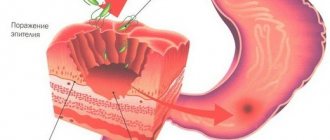Diagnostic features
Before starting treatment, you should make sure that the diagnosis is accurate.
Previously, to confirm such a diagnosis, it was necessary to use X-ray diagnostic methods; fluoroscopy can only determine fairly gross defects in the wall of the stomach and duodenum, although it reflects the contractile function quite well. A more modern and accurate method for diagnosing such diseases is fibrogastroduodenoscopy, which not only makes it possible to recognize the disease at an early stage, but also to accurately determine the size and location of the ulcerative defect, and also makes it possible to take a scraping.
Scraping may be necessary both if malignant degeneration is suspected, or if the Helicobacter pylori infection is resistant to treatment, and then the method is used to obtain the causative agent of the disease in a specific person and test the bacteria for resistance to antibacterial drugs.
Acidity is also measured, which is usually elevated in the case of peptic ulcers. The acidity indicator may also indicate the effectiveness of drugs from the group of proton pump inhibitors.
Among the non-invasive methods for confirming Helicobacter pylori infection, the urease breath test should be highlighted. The technique is based on the ability of Helicobacter pylori to break down urea into substances such as ammonia and carbon dioxide.
The patient is given a solution of urea labeled with a carbon isotope to drink. When broken down by bacterial urease, isotope-tagged carbon dioxide enters the bloodstream and is then excreted through the lungs.
Air samples are taken before drinking the urea solution, and half an hour after drinking. Based on the content of labeled carbon in the exhaled air, a conclusion is made about the presence of the bacterium Helicobacter pylori in the mucous membrane and its activity. However, it should be taken into account that a number of factors can affect the accuracy of the study.
Dosage regimens
Antibiotics for peptic ulcers are recommended to be taken according to the classical scheme, the essence of which is a combination of two antimicrobial agents with proton pump inhibitors. The latter allow you to achieve the maximum concentration of antibiotics on the surface of the gastric mucosa. If PPIs do not have the expected effect (if the acidity is too high), it is recommended to replace them with histamine receptor blockers.
Reception schemes look like this:
- The first line or regimen for treating stomach ulcers with antibiotics is a combination of Clarithromycin at a dosage of 500 mg twice a day and Amoxicillin at a dosage of 200-250 mg 2-3 times a day. This method is an initial one and therefore does not involve the use of Metronidazole tablets, while proton pump inhibitors are prescribed in usual dosages twice a day. If necessary, Clarithromycin or Amoxicillin can be replaced with Tetracycline.
- The second line of therapy involves the use of Tetracycline and Metronidazole tablets in dosages selected by the attending physician (usually the first antibiotic is taken 4 times a day, 0.5 g, and the second, 0.5 g three times a day). The action of antibiotics is supplemented with Almagel or Maalox and Omeprazole in regular dosages.
Antibiotic therapy can be supplemented with the drugs presented
If these regimens are ineffective, the gastroenterologist prescribes a combined antibiotic regimen—tritherapy or quadruple therapy. In the first case, the drugs Pilorid, Clarithromycin and Amoxicillin are combined. To implement quadruple therapy, a course of drugs Omeprazole, De-Nol, Metronidazole and Amoxicillin is prescribed. In both the first and second cases, the duration of treatment is 1 or 2 weeks.
Such multicomponent treatment regimens for peptic ulcers have proven to be highly effective against the Helicobacter bacterium, which has made it possible to maximize the relapse-free period of peptic ulcers in 80% of patients.
From the video you will learn which tablets are used to treat ulcers:
Antibiotics for stomach ulcers and many other diseases are prescribed quite often. However, with regard to this disease, treatment with such drugs must be approached as carefully as possible. Under no circumstances should you use antibiotics on your own initiative. These drugs must be selected by a doctor, and they can only be used according to a specific scheme. Often, when taking antibiotics, protective medications are additionally prescribed, which make it possible to restore the microflora of the stomach and intestines. In the presence of an ulcer, they play a very important role.
Peptic ulcer disease can occur in different ways. Sometimes there are great difficulties in treatment, since strong drugs are unacceptable, but antibiotics are needed for a speedy recovery. The modern pharmacological industry offers various options, including relatively safe antibiotics. But in any case, their use and dosage regimen must be agreed with the attending physician. Only in this case can you count on the fact that a stomach or intestinal ulcer, including the duodenum, will be eliminated correctly and without consequences.
Causes
The main etiological factor causing peptic ulcer disease is currently considered to be the bacterium Helicobacter pylori. The microbe lives in the stomach of the vast majority of people, but causes disease only in some, which is probably due to the individual characteristics of the immune response and the functioning of the mucous membrane of the stomach and duodenum.
Once on the gastric mucosa, the bacterium begins to synthesize urease, which leads to the local formation of ammonia and, as a consequence, to a decrease in the acidity of gastric contents.
This situation leads to a compensatory increase in the synthesis of hydrochloric acid and pepsin, which, when entering the duodenum, lead to the formation of ulcerative defects there. However, Helicobacter pylori is not the only cause of the disease.
The second most common cause of peptic ulcer disease is the uncontrolled use of non-steroidal anti-inflammatory drugs.
Preparations of this group, most of them being acids, are not only capable of having a direct irritating effect on the mucous membranes of the stomach and duodenum, but also by inhibiting the activity of the enzyme cyclooxygenase 1, they reduce the synthesis of prostaglandins, which in turn negatively affects the synthesis of protective mucus, making the mucous membranes more vulnerable to the effects of hydrochloric acid and enzymes.
More exotic and rare causes of peptic ulcer disease include gastrinoma, Crohn's disease, chronic obstructive pulmonary disease, chronic renal failure, and cirrhosis of the liver.
The following can contribute to the occurrence of peptic ulcers:
- Frequent drinking and smoking.
- Frequent stressful situations; gastroenterologists even have such a term as “stress ulcer.”
- Poor nutrition – excessive consumption of fatty, fried, too spicy foods, as well as semi-finished products contributes to the occurrence of gastric and duodenal ulcers.
There is evidence to suggest that night shift work may also be considered a risk factor.
What symptoms can be used to suspect a peptic ulcer?
One of the most characteristic manifestations of duodenal ulcer is pain in the upper abdomen, which can radiate to the hypochondrium, the left half of the chest, and, less commonly, to the thoracic or lumbar spine.
If in the case of a stomach ulcer pain appears soon after eating, then in the case of damage to the duodenum the pain usually appears after eating, after a couple of hours.
Also often observed are so-called hunger pains, which appear during a long break between meals and often appear at night. It is possible that existing pain may appear or intensify during physical activity.
Also, patients with duodenal ulcer may experience nausea and vomiting (although such manifestations are less common), and constipation. Moreover, this disease is characterized by seasonality - exacerbations are most often observed in spring and autumn. In some cases, the disease may be completely asymptomatic.
Peptic ulcer disease and antibiotics - when their use is justified
Studies of factors that provoke the appearance and development of peptic ulcer disease have shown that in more than 80% of cases the cause of this disease is the activity of the bacterium Helicobacter pylori. To get rid of the consequences of the activity of this bacterium and cure gastric ulcers, various antibacterial therapy regimens have been developed, in which antibiotics play a leading role.
These drugs are of natural or semi-synthetic origin; they inhibit the vital activity of cells of a certain type, which allows for the targeted destruction of pathogenic microorganisms. They are used with caution, carefully analyzing side effects and taking into account contraindications to the use of drugs.
Contraindications to the use of antibiotics
Amoxicillin and its substitutes are not prescribed for hypersensitivity to penicillins, lymphocytic leukemia, mononucleosis. It is also prescribed with caution if the patient has a tendency to bleed.
It is not allowed to use the product for liver failure, acute gastritis caused by salmonella, and shigellosis.
Clarithromycin is contraindicated in the following cases:
- childhood;
- renal failure;
- liver pathologies;
- hypoglycemia;
- arrhythmia.
You can find out about contraindications to taking other antibiotics prescribed for gastritis by reading the instructions.
You will have to refuse antibiotic treatment for a stomach ulcer if:
- individual intolerance to ingredients;
- tendency to exhibit allergic reactions;
- serious pathologies of the liver and kidneys;
- pregnancy and lactation.
In addition to the general contraindications listed above, each antibacterial drug has individual contraindications, which are indicated in the instructions.
If treatment for a stomach ulcer does not produce results or leads to a deterioration in health, then you need to stop taking the medications and contact a gastroenterologist so that he can select a different regimen.
Antibiotics for gastric ulcers should be selected more carefully than for gastritis. In the medical treatment of these two diseases, different drugs are used.
During the period of relapse, antibacterial therapy is mandatory. A properly selected treatment regimen can ensure the fastest possible recovery.
Features of antibiotic treatment
There are several rules, following which the patient significantly increases the success of treatment: On average, antibacterial therapy lasts 10-14 days inclusive. Its duration depends on the individual characteristics of the body. It is very important to take medications at regular intervals. It is advisable to take antibiotics after meals, as well as all complex medications prescribed by your doctor. Even if you notice a clear improvement in your well-being, you must complete the course completely.
Antibiotics in the absence of Helicobacter pylori
Experts say that the main indicator for prescribing antibacterial drugs is the presence of a bacterial infection in the body. But what if multiple studies haven't found it? Should I take antibiotics to eliminate peptic ulcers?
No, it's not worth it. In such cases, bismuth preparations, histamine receptor blockers, antispasmodics, antacids and others are considered effective. The choice depends only on the clinical picture of the disease, the patient’s condition and the specific specialist’s method of treating gastric ulcers.
Basic treatment regimens for the disease
For the complex treatment of gastric ulcers in the acute period, 3 main schemes are used, depending on the number of components:
- two-component;
- three-component;
- four-component.
Dual-component therapy
Two drugs are prescribed, one of which is antibacterial, the other with gastroprotective and antacid effects: amoxicillin and omeprazole, they are taken 2 times a day for 14 days, followed by a control bacterial analysis. There may be other combinations, for example, metronidazole and de-nol, tetracycline and omeprazole. The effectiveness of this therapy is about 50%.
Triple therapy
A three-component treatment regimen is used as first-line therapy. The recommended course of treatment for gastric ulcers is from 7 to 14 days. After the treatment is completed, the so-called eradication control is carried out - the waste products of the bacteria are re-determined in the blood and feces, in the exhaled air. Typically, the effectiveness of therapy reaches 90%.
This type of treatment provides 2 three-component options with combinations of various drugs.
Antibacterial therapy for the first option consists of:
- Proton pump inhibitor (PPI) - traditionally used Omeprazole (Omez) in the usual dosage 2 times a day;
- Macrolide antibiotic “Clarithromycin”, prescribed in a dose of 0.5 g 2 times a day;
- Semi-synthetic penicillin - Amoxicillin at a dose of 1 g 2 times a day.
The second option involves prescribing the antiprotozoal drug Metronidazole instead of Amoxicillin.
Stomach ulcer treatment regimen
Quadruple therapy
If treatment of a stomach ulcer with first-line antibiotics is not successful, a repeat course of eradication therapy is prescribed, but according to a different scheme. It includes:
- PPI – in standard doses 2 times a day;
- Antacid - Bismuth subcitrate (Vis-Nol) - 0.12 g 4 times a day;
- Antiprotozoal drug: Metronidazole – 0.5 g 3 times a day;
- Antibiotic of the tetracycline group: Tetracycline 0.5 4 times a day.
It is also necessary to undergo treatment according to the quad scheme for at least 7 days. After treatment, its effectiveness is also assessed.
Stomach ulcers of bacterial origin include both antibiotics and the prescription of other drugs (antispasmodics, eubiotics or probiotics, and sometimes enzyme preparations) in their therapy.
Combination therapy
This method of treatment is used in a situation where the previous ones did not give the proper result. It is mainly prescribed during exacerbation of gastrointestinal diseases. Involves the simultaneous use of 2 different antibiotics and 2 mutually reinforcing agents. Combine Amoxicillin, Clarithromycin, Tetracycline and Metronidazole.
Proton pump inhibitors are mainly used in this therapy. If they did not help the patient due to his personal sensitivity to the drug, then H2-histamine receptor blockers are prescribed. The second drug is a drug from another subgroup that complements the treatment with the missing effect. The course of treatment lasts up to 1 week.
Complex treatment of stomach ulcers - groups of drugs
A stomach ulcer cannot be cured with antibiotics alone, since it is a complex lesion that affects the most complex mechanisms of the digestive process. For complex treatment, drugs from various pharmacological groups are used:
- Histamine receptor blockers - used to reduce the production of hydrochloric acid. These are Quatemal, Cimetidine, Famotidine, Ranitidine, Roxatidine.
- Proton pump inhibitors - drugs in this group are used in the complex treatment of acid-dependent disorders of the stomach by blocking the proton pump, which produces acid that aggressively acts on the mucous membrane. An excellent addition to antibiotic therapy for ulcers would be Omeprazole, Nolpaza, Esomeprazole, Omez.
- Gastroprotectors are astringent and enveloping agents to protect the inner lining of the stomach from the destructive effects of hydrochloric acid. This group includes Sukrafalt, Keal, Sukras, Venter. The result of the action of gastroprotectors is the protection of the mucous membrane in conditions of disturbed acid-base balance.
- Anticholinergics - to block the influence of the nervous system on the functioning of the muscles responsible for contraction of the stomach. Gastrozepine, Gastroceptin, Pirenzipine, Telenzelin. Thanks to the action of drugs in this group, the tone of the transverse muscles of the stomach increases and the production of overly active gastric juice decreases.
- Antacids - to neutralize hydrochloric acid. Maalox, Almagel, Phosphalugel will relieve pain and burning and eliminate negative symptoms.
- Ganglion blockers - used to inhibit the transmission of nerve impulses that cause contractile and secretory activity;
- Antispasmodics - to relieve muscle spasms, relieve pain in the stomach, and improve blood circulation in its walls.
- Bismuth-containing preparations - to reduce the activity of the bacterium Helicobacter pylori, envelop inflamed areas of the mucous membrane with a protective layer, and neutralize enzymes. De-nol, Vikain, Vikair, Vis-nol alleviate the symptoms of the disease.
- Prokinetics - to streamline metabolism and stimulate complete digestion. Motilium, Ganaton, Metoclopramide, Motilak relieve unpleasant symptoms (vomiting, nausea, heartburn), the effectiveness of prokinetics doubles when used together with antiseptics.
In addition to the above remedies, vitamin complexes enriched with microelements are used. It is optimal to use these drugs during the rehabilitation period; they help restore the affected mucous membrane and activate metabolism.
The most effective antibiotics
What antibiotics are the most effective for stomach ulcers? Currently, there is more than one effective treatment regimen for ulcerative pathology with the medications in question. In this case, the following types of medications are most often prescribed:
- Amoxicillin for ulcers;
- Amoxiclav;
- Clarithromycin;
- Tetracycline;
- Metronidazole.
Each of the above drugs has a specific principle of action and is prescribed taking into account the individual characteristics of the patient’s body. In view of this, it is worth taking a closer look at these dosage forms.
Amoxicillin
Helicobacter pylori is very sensitive to amoxicillin both in vivo and in vitro. Like other penicillins, amoxicillin acts by inhibiting the synthesis of the bacterial cell wall, which leads to the death of the pathogen. Amoxicillin has local intraluminal activity at the level of the gastric mucosa, as well as systemic activity. Unlike ampicillin, amoxicillin is actively released into the gastric juice from the bloodstream. Although amoxicillin is secreted into the gastric juice and mucosa during oral therapy, it achieves an H pylori eradication rate of less than 20%.
More than 2 g of amoxicillin per day does not increase the rate of H. pylori eradication when used as a single agent. However, when it is taken in combination with omeprazole, the concentration of amoxicillin in gastric juice and the effectiveness of its eradication are significantly increased. It is hypothesized that this enhanced eradication occurs due to omeprazole's reduction in gastric secretion, thereby increasing intragastric concentrations of amoxicillin. The advantage of using amoxicillin is that H pylori does not develop resistance to it.
Amoxicillin plus proton pump inhibitor
German studies report eradication rates of 80% to 85% with omeprazole (20 mg twice daily) and at least 1 g amoxicillin twice daily. Other studies have shown that the overall eradication rate using this dual therapy is approximately 60%. Today, amoxicillin in combination with a proton pump inhibitor is no longer considered an adequate treatment to eradicate the bacterium.
Amoxiclav
For ulcers and gastritis, Amoxiclav is often prescribed. This drug is a combination drug containing clavunolic acid and amoxicillin. Clavunolic acid has an inhibitory effect on bacteria. Due to this, pathological microflora becomes vulnerable to the effects of antibiotics.
Amoxiclav can be purchased in two forms: powder for preparing a suspension and tablets. The medicine is prescribed only by the attending physician.
Clarithromycin
The drug is from the same line to which Erythromycin belongs, successfully used by more than one generation of patients. In comparison, Clarithromycin is much more resistant to the effects of hydrochloric acid, is quickly absorbed and has a long period of effect on the human body. In the absence of contraindications for use, it is the main remedy from the pharmacological group of drugs for the treatment of stomach ulcers.
Clarithromycin plus proton pump inhibitor
A recent study found that two weeks of clarithromycin (500 mg three times daily) plus omeprazole (40 mg/day) followed by two additional weeks of omeprazole achieved an eradication rate of 83%. Reducing the clarithromycin dose to 250 mg twice daily in this regimen reduces the eradication rate to 62.1%. Studies that used a lower dose of omeprazole (usually less than 40 mg/day) also had lower eradication rates. Comparable results have been described with lansoprazole and clarithromycin. The eradication rate was 72.4% using lansoprazole (30 mg twice daily) and clarithromycin (400 mg twice daily) for 2 weeks.
Groups of traditional therapy drugs
Despite the effectiveness of antibacterial agents, even they do not have magical properties and require the support of other pharmacological groups. Only such an integrated approach will help you achieve the desired result as quickly as possible.
| Preparations containing bismuth | Aimed at inhibiting the activity of Helicobacter pylori. In addition, they have an enveloping property, “resuscitating” damaged areas of the gastric mucosa and thereby easing the acute period of the disease. |
| Antispasmodics | Prescribed to relieve pain and improve blood circulation in the gastrointestinal tract. |
| Histamine receptor blockers | Reduces the production of hydrochloric acid, the excess of which irritates damaged mucous membranes. |
| Anticholinergics | They act in two directions at once: they block nerve endings in the muscle tissues of the stomach/activate the transverse muscles, inhibit the production of gastric juice. |
| Proton pump inhibitors | They block the release of hydrochloric acid, protecting the gastric mucosa from its aggressive effects. |
| Antacids | Effectively eliminate the symptoms of peptic ulcer, namely pain, burning sensation, nausea. |
| Prokinetics | They take on the digestive function, stimulating metabolic processes. In addition, they can be used to relieve unpleasant symptoms. ATTENTION! It is better to take prokinetics in combination with other antiseptic drugs. |
| Ganglioblockers | They inhibit impulses of the nervous system and are aimed at regulating contractile/secretory processes. |
| Gastroprotectors | Particularly effective when the balance of the acid-base environment is disturbed. Their spectrum of action is aimed at enveloping the gastric mucosa, as well as protecting it from the pathogenic effects of hydrochloric acid. |
Which of these drugs will help antibiotics eliminate the pathogenic microorganism and cure the ulcer is decided only by a gastroenterologist based on the examination results.
To support a weakened immune system, vitamin complexes, iron supplements (if anemia has been diagnosed) and additional sources of vitamin B12 will also be prescribed.
How long does the treatment last?
The standard course of treatment using the Maastricht recommendations is seven days. However, it has also been proven that a longer course, if well tolerated by the patient, is more effective. Such treatment, depending on the situation, can also be prescribed for ten or fourteen days.
However, if ineffective, the course of treatment can be extended, but with the use of other antibacterial agents, after determining the sensitivity of the pathogen to antibiotics.
Features of the treatment of ulcerative lesions of the gastrointestinal tract
Ulcer treatment will not be effective if a specialist does not draw up a competent medication treatment regimen. It is necessarily formed with the use of antibiotics. These drugs are prescribed to suppress the development and growth of Helicobacter pylori, which is the main bacterium and duodenum.
After a suitable antibacterial agent has been selected, technical rules of therapy and additional drugs that will increase the effectiveness of treatment are selected. For each specific patient, it is selected individually, depending on the clinic of the disease.
If pathological defective changes in the mucous membrane of the duodenum or stomach have reached the stage of exacerbation, dynamic principles are used when providing care to patients. In this case, enhanced treatment is applied, distributed over 10 days. During this entire time, the patient is prescribed a strict diet and bed rest.
After all the manipulations undertaken have been successful, preventive therapy is prescribed. It includes both medications and folk remedies. The list of medications prescribed during this period is focused on the causes of the pathology:
- Antibacterial drugs that inhibit the development and growth of pathogenic microorganisms.
- Antiulcer agents with a high content of bismuth.
- Antisecretory drugs that normalize the acidic environment.
The primary task of the attending physician before prescribing medications is to assess the general physiological condition of the patient. This is necessary in order to draw up an adequate treatment plan, since intensive antibiotic therapy for a weakened body can result in the development of severe complications.
Antibiotic injections for stomach ulcers
Prescription of injections in the treatment of stomach and duodenal ulcers is used only in severe cases of the pathology. At the same time, other categories of drugs are used that have the necessary effect and have fewer negative side effects and contraindications compared to antibiotics:
- No-spa is administered intramuscularly to obtain an analgesic and antispasmodic effect;
- Ranitidine, by its nature, has antibacterial properties and, when released into the blood, promotes the healing of ulcers and the normal production of gastric juice;
- Cerucal is prescribed to restore intestinal function;
- Papaverine is used to strengthen the gastric mucosa and relieve severe heartburn during exacerbation;
- Actovegin in injections promotes wound healing, relieves pain, prevents bleeding and stabilizes the functioning of the digestive system.
Doctors categorically do not recommend the use of certain categories of drugs that can worsen the general condition of the patient: Aluminum hydroxide, which causes constipation and disrupts the normal functioning of the digestive tract; taking aspirin and Citramon, since these medications contain acid and can contribute to further progression of the ulcer; Diazinon may cause additional irritation of the mucous membrane and cause bleeding in the stomach.
Injection medications for the treatment of ulcers have distinct advantages over oral medications:
- further rapid absorption into the general bloodstream and provision of the desired effect;
- eliminating additional irritation of the mucous membrane, since the drug is absorbed through the blood;
- rapid healing of the resulting ulcer if the prescribed treatment regimen is followed.
This treatment method is effective for complicated stages of gastric ulcers and a high risk of developing an oncological process at the site of damage to the gastric mucosa. Self-administration of drugs can cause a severe allergic reaction and lead to serious complications that negatively affect the general condition of a person.
Contraindications for treating ulcers with antibiotics
The list of contraindications to the use of antibacterial agents is limited to the following items:
- Individual intolerance to the components of the drug;
- Allergic reaction;
- Pregnancy and lactation;
- Kidney failure;
- Liver failure.
In addition, each antibiotic has special contraindications unique to this drug:
- Amoxicillin – lymphocytic leukemia, mononucleosis, history of digestive system pathologies.
- Clariromycin – porphyria.
- Metronidazole is a sensitizer of the body that provokes asthma attacks.
A careful selection by a gastroenterologist of a treatment regimen, supplemented with various drugs to eliminate the symptoms of the disease, will allow the damaged gastric mucosa to be restored in the shortest possible time, relieve pain and negative manifestations of the disease.
16.03.2017
Often, when a patient is diagnosed with a stomach ulcer, two main reasons for the development of the disease can be identified:
- The patient did not observe obvious signs of illness or did not pay attention to the discomfort. The reason for visiting the doctor’s office was sudden severe pain and a diagnosis that would take many years to resolve.
- Treatment was started from the first days of discomfort, but the drugs were prescribed by the patient himself, without any examinations or consultations. The result: time/money/effort wasted and an “ulcer” was earned.
There is still that percentage of people who went to the doctor and followed his instructions, but the recommendations for correcting their diet were ignored. Or between traditional therapy and traditional medicine, preference was given to the latter. As a result, there is almost no result, and the situation is so advanced that it is no longer possible to do without antibacterial drugs and radical methods of treatment...
Gastric ulcer is a disease of the gastrointestinal tract, which is characterized by inflammatory processes in the gastric mucosa, as well as damage to the deep muscles.
The main reasons for the development of this pathology are:
- Penetration of the pathogenic bacterium Helicobacter pylori into the body. It is this that provokes the destruction of the mucous membrane of the digestive organ.
- Lack of diet, low quality food, regular overeating/abuse of fast food, salty/spicy/smoked/fried/fatty foods.
- Alcohol addiction, smoking.
- Constant stress, depression, psychological tension.
As practice shows, the first item on the list “starts the mechanism”, and all subsequent ones move it forward. Conclusion: treatment should be comprehensive, consisting of antibacterial drugs, giving up bad habits, diet, emotional stability and traditional medicine.
Many opponents of “antibiotics” are interested in the question “are they necessary for stomach ulcers and what can replace them?” The answer is clear: if Helicobacter pylori is present in the body, only antibacterial therapy can stop its reproduction and pathogenic activity.
Its main component (antibiotics) is of semi-synthetic/natural origin and is aimed at inhibiting/destructing pathogenic cells. Moreover, each drug is designed for a specific type of bacteria, so the patient cannot choose it independently.
IMPORTANT! Self-medication is fraught with serious complications and side effects! Antibiotics for stomach ulcers should be selected only by a specialist after an appropriate examination, and should be taken strictly according to the regimen, in the prescribed dosage.
The absence of antibacterial treatment, in turn, will lead to the progression of the disease, exacerbation of symptoms (pain, nausea, vomiting, weakness, blood in the stool, inadequate digestion of food, heaviness in the stomach, rapid weight loss, vitamin deficiency, anemia, belching with a putrid odor ). The final stage will be oncology, which is rightfully considered a death sentence for the patient.
Antibiotics in capsules for stomach and duodenal ulcers
During the treatment regimen for stomach and duodenal ulcers, doctors pay special attention to the use of antibiotics in capsules, since the presence of a protective shell helps to prevent unnecessary irritation of the mucous membrane and further development of the disease. The list below presents the main drugs for the treatment of ulcers in capsule form.
- Azimed. Antibiotic in the form of capsules and suspensions containing Azithromycin with a pronounced antibacterial effect. The drug is prescribed for various inflammatory infections, stomach and duodenal ulcers. The dosage for complex therapy is 1 gram per day for 3 days. Contraindications: taking ergot derivatives, allergic manifestations, children in the weight category up to 45 kg.
- AzitRus. An effective drug with an antibacterial effect in the form of capsules. The main substance Azithromycin dihydrate ensures the elimination of Helicobacter pylori during the development of gastric ulcers. The dosage of the medicine is prescribed individually by the attending physician. Contraindications: pregnancy, breastfeeding, liver and kidney dysfunction, allergies, children under 3 years of age.
- Clarbuckt. An effective antimicrobial antibiotic containing Clarithromycin. Indications for use: treatment of infectious diseases of various etiologies, combination therapy of gastric ulcers in the elimination of Helicobacter pylori. Dosage 500 mg twice a day for 14 days. Contraindications: liver and kidney dysfunction, intolerance to the main components, Porphyria phenomenon, pregnancy, breastfeeding.
- Zitrolide. Systemic antibiotic in the form of capsules containing Azithromycin. The medicine is effective in the complex treatment of stomach ulcers, duodenal ulcers and other diseases caused by various pathogenic microorganisms. The dosage for ulcerative lesions is 1 gram per day for 3 days. Contraindications: liver and kidney dysfunction, pregnancy, lactation, intolerance to the main composition, children weighing up to 45 kg.
- Ecomed. One of the most effective antibiotics in the form of capsules, tablets and powder. Indications for use: infectious diseases of various etiologies (tonsillitis, laryngitis, scarlet fever, pneumonia, bronchitis, dermatosis), combined treatment of stomach ulcers to eliminate Helicobacter pylori. The dosage is 1 gram per day for 3 days. Contraindications: macrolide intolerance, liver and kidney dysfunction, pregnancy, breastfeeding.
Disadvantages of antibacterial drugs
The main disadvantage of antibacterial drugs is the high risk of adverse reactions. With long-term use of antibiotics, changes in the central nervous system can be observed. Dizziness, hallucinations, confusion, apathy, depression, and convulsions may occur. Such consequences, of course, are not expected by everyone, since drugs are prescribed strictly according to indications and possible risks are always taken into account. Serious adverse reactions are an absolute contraindication to the use of antibiotics without a doctor's prescription.
Possible side effects:
- disorders of the gastrointestinal tract - diarrhea, dysbacteriosis, pain;
- difficulty urinating, temporary urinary incontinence;
- disruption of the kidneys and liver.
All antibacterial drugs, including the relatively safe Klacid SR, can, under certain conditions, lead to unpleasant consequences. The mildest adverse reactions include headache and dizziness. The consequences also include unreasonable fear, anxiety, insomnia and nightmares. In some cases, the body reacts with disorientation, psychosis, and depersonalization, but this happens extremely rarely. More often, complications such as vomiting, nausea, dental diseases, frequent urination, and tinnitus can be observed. From the circulatory system there is a risk of bleeding and thrombocytopenia. Even more often, allergic reactions may occur, which is manifested by skin itching, rash, and redness.
Treatment with antibiotics for liver disease should be constantly monitored, as with pathologies of the cardiovascular system.
Taking antibiotics without a doctor's prescription can lead to dyspeptic symptoms, dysbiosis and kidney failure. Without the help of a specialist, it is difficult to predict how self-medication will turn out, and if one person’s ulcer symptoms subside after a few days, another may end up in the intensive care unit.
It is important to know
Antibiotics for stomach and duodenal ulcers are necessarily included in the drug treatment regimen. But therapy that can save a person from developing pathological defects in these parts of the gastrointestinal tract should only be carried out in combination. A unilateral approach, without the use of preventive measures, will be ineffective.
In order to forget about the disease, antibacterial agents alone, although they are considered basic, are not enough. In order to speed up the recovery process, specialists in the treatment of patients with peptic ulcer and duodenal ulcer use various groups of drugs in combination. They are selected depending on what caused the disease and at what stage of development it is.
Possible side effects
Along with undoubted therapeutic advantages, antibiotics have a number of disadvantages and side effects. The risk of developing these when taking an antibiotic, especially uncontrolled, is high.
- Long-term use of antibiotics adversely affects the functions of the central nervous system. Auditory and visual hallucinations, dizziness, apathy, depressive states may occur, and consciousness is sometimes darkened or confused. The development of convulsive syndrome is possible. Of course, such consequences from taking antibiotics are not possible for every patient, but this should be kept in mind. Antibiotics have strict indications for use. The appearance of serious side effects becomes a reason to discontinue medications and select an alternative treatment regimen.
- From the stomach and intestines, nausea, vomiting, diarrhea, abdominal pain and dysbacteriosis may occur.
- Disorders of the urinary system, temporary urinary retention or urinary incontinence.
- Liver disorders.
Antibiotics are not prescribed during pregnancy. Antibiotics should be used with caution if there is a marked decrease in immune defense.
Every antibacterial drug, even a safe one, in a certain scenario leads to the development of unpredictable complications. Mild consequences from uncontrolled use of antibacterial drugs are headache and dizziness. Long-term and severe sleep disorders, high anxiety, prolonged depression and fears are described as severe symptoms. In difficult cases, the body reacts to the use of antibacterial therapy with acute psychotic states, depersonalization and disturbances in orientation in the environment. Such side effects are extremely rare.
Much more often, doctors observe side effects in the form of nausea, diarrhea, and vomiting. Possible violations of the dental plan. The blood system sometimes reacts by decreasing the level of platelets and leukocytes and developing bleeding. Allergic reactions to antibacterial drugs are common. They manifest themselves in the form of dermatitis or bronchitis, skin rash, and fever.
If even the slightest signs of a side effect appear, you need to stop taking the drug and consult a doctor.
What antibiotics are the most effective?
It would be correct to answer: “Those that are most accurately selected for a particular clinical picture.”
But, as practice shows, pharmacology identifies 4 of the most effective drugs with an antibacterial spectrum of action:
- Metronidazole. An antibacterial drug of synthetic origin, aimed at eliminating pathogenic bacteria. Once in the body, it blocks the tissue respiration of Helicobacter pylori, as a result of which its ability to reproduce is lost. After a short time, the bacterium dies. The course of treatment is at least 2 weeks, the dosage is prescribed strictly individually.
- Clarithromycin. One of the drugs that is not affected by the acid-base environment. In addition, it practically does not penetrate into the blood plasma, but is perfectly separated in the tissues of the body. It is part of the macrolide group and is often considered the most effective. Its prescription must be justified in detail, especially if the patient is already taking other medications. Only when their compatibility has been verified can treatment begin. Otherwise, the consequences can be very serious.
- Amoxicillin. It is a representative of the penicillin action group, which blocks the development of pathogenic microorganisms. It acts quite quickly, within 7-8 hours. For stomach ulcers, it is taken on an empty stomach (exceptions are made for those patients whose gastric mucosa reacts acutely to the drug). It has a number of contraindications (allergic reactions, bronchial asthma, liver diseases).
- Tetracycline. It is rightfully at the bottom of the ranking of effective drugs, since it is not resistant to hydrochloric acid. It is rarely prescribed for stomach ulcers. Available in the form of tablets that taste quite bitter.
IMPORTANT! None of these antibiotics are prescribed without the accompaniment of other drugs: antacids, inhibitors, antispasmodics, etc.











